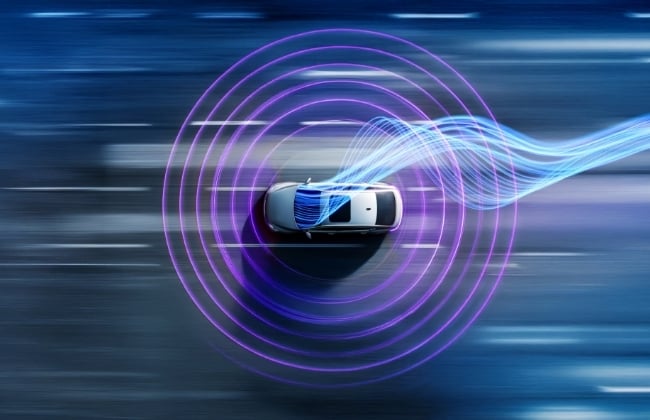- 09 May 2022
- Bryce Johnstone
Autonomous vehicle (AV) development is gaining momentum, with major players such as Renesas, driving innovation for Level 2+ and Level 3 solutions, part of the industry-standard six levels of autonomous driving. The new R-Car V4H SoC from Renesas brings significantly more performance in deep learning, enabling fast image recognition and processing of surroundings via automotive sensors (cameras, radar, and lidar).
Cities are also preparing for the autonomous revolution through laws, regulations, and infrastructures. Germany, Japan, and South Korea have become the first countries to support a legal basis for Level 3 driving solutions – with manufacturers such as Mercedes-Benz racing for international validation to start production on Level 3 vehicles.

Even at these lower levels of autonomy cars can generate 25GB of data per hour from a variety of sensors, so high-performance, low-power SoC is an essential piece of the puzzle. When it comes to full AVs, the automotive SoC represents the foundation on which manufacturers build their solutions, and dedicated AI accelerators inside of these are the traditional component associated with powering AI for autonomous driving. However, what some don’t appreciate is that the conventional GPUs can also play a vital role in processing sensor input as their architecture is designed with parallel computing in mind.
More than meets the eye
When it comes to GPUs in automotive applications most people will associate them with running in-vehicle displays and dashboards – but GPUs are capable of so much more. Specifically, they can display and power the advanced driver assistance systems (ADAS) that come as a standard in today’s cars.
GPUs represent a massively parallel processing element and thanks to its architecture, in some cases, code that traditionally runs on CPUs can be optimised to perform up to 20x faster when run on the GPU. That can be further boosted with the help of an AI accelerator, such as the neural network accelerator (NNA) from Imagination, resulting in significant power savings – a key concern when it comes to electric vehicles (EVs), which will be the most common platform for autonomous solutions.
When it comes to AV requirements GPUs are tailor-made for the task – being able to perform image analysis and parallel signal processing. As image processing is a natural fit for this type of component, ADAS platforms can leverage GPU parallel compute to analyse sensor data in real-time from lidar, radar, and infra-red cameras.
Fuelling advanced compute
With over 15 years of experience in the automotive sector, Imagination IP is one of the leading solutions deployed in the market. Cumulatively, we have shipped in over 300m cars and trucks and have a near 50% market share for graphics in automotive application processors. Many of these feature the Renesas R-Car SoC, which is a widely deployed automotive platform that features Imagination GPU IP. We also bring to bear our history in mobile phones which drives us to optimise our power budgets and therefore reduce battery requirement and increase range.
IMG B-Series multi-core GPU IP offers a wide range of performance points for low-power-optimised embedded graphics, bringing together performance density with power-efficient solutions. IMG BXS cores are specifically designed for automotive safety – built using processes that have been independently verified to conform to ISO 26262, making it quicker for customers to integrate into their systems that are designed to be functionally safe.
Cores such as IMG BXS are designed to both power high-resolution digital dashboards and for ADAS, with greater efficiency than other cores on the market. BXS features such as the Tile Region Protection (TRP) allow render checks to be performed only on those parts of the screen displaying safety-critical information – maximising performance while maintaining safety.
Software-driven integration
GPUs can bring more flexibility to SoC design, as they can tackle all the ADAS processes mentioned earlier. Our GPU safety cores, such as our IMG BXS, and our safety-critical driver, are designed to be ASIL B compliant for protection against permanent and transient fault.
This means manufacturers have a solid foundation to build their AVs, with the added scalability of NNAs, while keeping power optimised. The last part is essential, as AV is becoming more and more synonymous with EVs.
As the AV market and functionality develop and evolves, the need to be able to adapt the software in a vehicle to maintain functionality, safety, and security increases. We expect to see more differentiation being offered by OEM vendors through their software implementations than has traditionally been seen in the past.
Developers can leverage software to fine-tune and optimise their SoCs – balancing both GPU and NNA for performance and efficiency. We enable this for our products with a highly-capable SDK offering, providing continuity for the IP flexibility when it comes to software. We also deliver a software driver that is compliant with the Khronos OpenGL safety-critical standard.
Imagination as a one-stop-shop
Heterogeneous computing has been brought into the spotlight recently across the industry, and for good reason. By approaching SoC development with heterogeneity in mind, OEMs can unlock greater energy efficiency and flexibility, making use of specific processor architectures to run different parts of their workloads on advantages such as the GPU compute parallelism.
With our recently announced Catapult RISC-V CPU, we now offer manufacturers the possibility to create a full-Imagination SoC – including CPU, GPU, and NNA. This provides a variety of benefits, such as offloading AI to the NNA and performing much of the image capture processes on the GPU. This enables unprecedented flexibility in design, with precise control over multiple parallel workloads.






